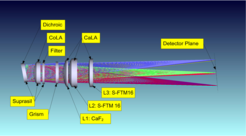Optical Design

Fig. 1. This figure illustrates the opto-mechanical design of the NISP instrument, which consists of the CoLA and CaLA optical systems, the NI-SA panels (1,2), the filter- and Grism wheel meachanisms as well as the FPA beams and bipods.
The NISP optical design combines two functions of the instrument: photometry and spectroscopy. The imaging is realised with a common optical system and two moving elements: the dispersive element (grism) and the bandpass filter, both mounted on separate wheels (Grating Wheel Assembly and Filter Wheel Assembly). For the spectroscopic mode only the grism is present, while during photometric observations the filter is active in the optical system. The replacement of the movable parts is accomplished by the mechanisms of FWA and GWA. The optical I/F of the instrument is the dichroic mirror that reflects the visible and transmits the near infrared light. First lens of the system is the Corrector Lens Assembly (CoLA). Optically the aspherical lens actively takes part in the colour correction of the image, yet it has only small power. During photometric observations different filters can be activated, which are accommodated in the FWA. In the spectroscopic mode 4 different grisms disperse the light, which are mounted in the GWA. During an observation either one filter of the FWA or one grism of the GWA is active and a go-through position is available in both wheels in order to separate the photometric and spectroscopic function of the instrument. The Camera Lens Assembly (CaLA) consists of 3 aspherical lenses that focus the light to the detector array system. The large FoV of the Euclid telescope results in relative large (Ø170 mm) lenses and filters; hence, in large FWA, GWA, and FPA.
The 2D model of the NISP optical design is shown in the Fig. 1. It shows
- The corrector lens CL (L4) together with its holding structure will be furthermore called Corrector Lens Assembly (CoLA). CL is a spherical-aspherical meniscus type lens. CL is made from fused silica.
- The filter with mildly powered spherical entrance surface and flat exit surface. The substrate material is fused silica.
- The grism with mildly powered spherical entrance surface and binary optic (curved line) grating exit surface. The grism material is fused silica.
- The three lenses L1-L3 together with their holding structure will be furthermore called Camera Lens Assembly (CaLA).
- L1 a spherical-aspherical meniscus lens made from CaF2.
- L2 a spherical-aspherical meniscus lens made from S-FTM16.
- L3 a spherical-aspherical meniscus lens made from S-FTM16.
